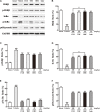Curcumin's Metabolites, Tetrahydrocurcumin and Octahydrocurcumin, Possess Superior Anti-inflammatory Effects in vivo Through Suppression of TAK1-NF-κB Pathway
- PMID: 30386242
- PMCID: PMC6199526
- DOI: 10.3389/fphar.2018.01181
Curcumin's Metabolites, Tetrahydrocurcumin and Octahydrocurcumin, Possess Superior Anti-inflammatory Effects in vivo Through Suppression of TAK1-NF-κB Pathway
Abstract
Curcumin (CUR), a promising naturally occurring dietary compound, is commonly recognized as the potential anti-inflammatory agent. While the application of CUR was hampered by its low stability and poor systemic bioavailability, it has been suggested that the biological activities of CUR are intimately related to its metabolites. In the current investigation, we aimed to comparatively explore the anti-inflammatory effects of tetrahydrocurcumin (THC), octahydrocurcumin (OHC), and CUR, and to elucidate the underlying action mechanisms on experimental mice models of acute inflammation, i.e., xylene-induced ear edema, acetic acid-induced vascular permeability, and carrageenan-induced paw edema. The results showed that THC and OHC exerted significant and dose-dependent inhibitions on the formation of ear edema induced by xylene and paw edema provoked by carrageenan and inhibited the Evans blue dye leakage in peritoneal cavity elicited by acetic acid. Moreover, THC and OHC treatments were more effective than CUR in selectively inhibiting the expression of cyclooxygenase 2 (COX-2) and suppressing nuclear factor-κB (NF-κB) pathways via transforming growth factor β activated kinase-1 (TAK1) inactivation in the carrageenan-induced mouse paw edema model.
Keywords: COX-2; TAK1-NF-κB pathway; curcumin; inflammation; octahydrocucumin; tetrahydrocurcumin.
Figures




 p < 0.001 vs. the CUR group. Significant differences between groups were determined by ANOVA and Dunnett’s post hoc test.
p < 0.001 vs. the CUR group. Significant differences between groups were determined by ANOVA and Dunnett’s post hoc test.
 p < 0.001 vs. the CUR group. Significant differences between groups were determined by ANOVA and Dunnett’s post hoc test.
p < 0.001 vs. the CUR group. Significant differences between groups were determined by ANOVA and Dunnett’s post hoc test.
 p < 0.001 vs. the CUR group. Significant differences between groups were determined by ANOVA and Dunnett’s post hoc test.
p < 0.001 vs. the CUR group. Significant differences between groups were determined by ANOVA and Dunnett’s post hoc test.
 p < 0.001 vs. the CUR group. Significant differences between groups were determined by ANOVA and Dunnett’s post hoc test.
p < 0.001 vs. the CUR group. Significant differences between groups were determined by ANOVA and Dunnett’s post hoc test.
Similar articles
-
Comparation of Anti-Inflammatory and Antioxidantactivities of Curcumin, Tetrahydrocurcuminand Octahydrocurcuminin LPS-Stimulated RAW264.7 Macrophages.Evid Based Complement Alternat Med. 2020 Dec 22;2020:8856135. doi: 10.1155/2020/8856135. eCollection 2020. Evid Based Complement Alternat Med. 2020. PMID: 33424997 Free PMC article.
-
Tetrahydrocurcumin and octahydrocurcumin, the primary and final hydrogenated metabolites of curcumin, possess superior hepatic-protective effect against acetaminophen-induced liver injury: Role of CYP2E1 and Keap1-Nrf2 pathway.Food Chem Toxicol. 2019 Jan;123:349-362. doi: 10.1016/j.fct.2018.11.012. Epub 2018 Nov 10. Food Chem Toxicol. 2019. PMID: 30423402
-
Anti-inflammatory activity of coptisine free base in mice through inhibition of NF-κB and MAPK signaling pathways.Eur J Pharmacol. 2017 Sep 15;811:222-231. doi: 10.1016/j.ejphar.2017.06.027. Epub 2017 Jun 23. Eur J Pharmacol. 2017. PMID: 28648405
-
Tetrahydrocurcumin-Related Vascular Protection: An Overview of the Findings from Animal Disease Models.Molecules. 2022 Aug 10;27(16):5100. doi: 10.3390/molecules27165100. Molecules. 2022. PMID: 36014335 Free PMC article. Review.
-
Positive Tetrahydrocurcumin-Associated Brain-Related Metabolomic Implications.Molecules. 2023 Apr 26;28(9):3734. doi: 10.3390/molecules28093734. Molecules. 2023. PMID: 37175144 Free PMC article. Review.
Cited by
-
Based on Network Pharmacology and Molecular Docking, the Active Components, Targets, and Mechanisms of Flemingia philippinensis in Improving Inflammation Were Excavated.Nutrients. 2024 Jun 13;16(12):1850. doi: 10.3390/nu16121850. Nutrients. 2024. PMID: 38931205 Free PMC article.
-
Mechanistic Differences in the Inhibition of NF-κB by Turmeric and Its Curcuminoid Constituents.J Agric Food Chem. 2020 Jun 3;68(22):6154-6160. doi: 10.1021/acs.jafc.0c02607. Epub 2020 May 20. J Agric Food Chem. 2020. PMID: 32378408 Free PMC article.
-
A Stability-Indicating Assay for Tetrahydrocurcumin-Diglutaric Acid and Its Applications to Evaluate Bioaccessibility in an In Vitro Digestive Model.Molecules. 2023 Feb 9;28(4):1678. doi: 10.3390/molecules28041678. Molecules. 2023. PMID: 36838664 Free PMC article.
-
3D-Printed Mucoadhesive Collagen Scaffolds as a Local Tetrahydrocurcumin Delivery System.Pharmaceutics. 2021 Oct 15;13(10):1697. doi: 10.3390/pharmaceutics13101697. Pharmaceutics. 2021. PMID: 34683989 Free PMC article.
-
Microemulsion-Based Keratin-Chitosan Gel for Improvement of Skin Permeation/Retention and Activity of Curcumin.Gels. 2023 Jul 21;9(7):587. doi: 10.3390/gels9070587. Gels. 2023. PMID: 37504466 Free PMC article.
References
LinkOut - more resources
Full Text Sources
Other Literature Sources
Research Materials
Miscellaneous

